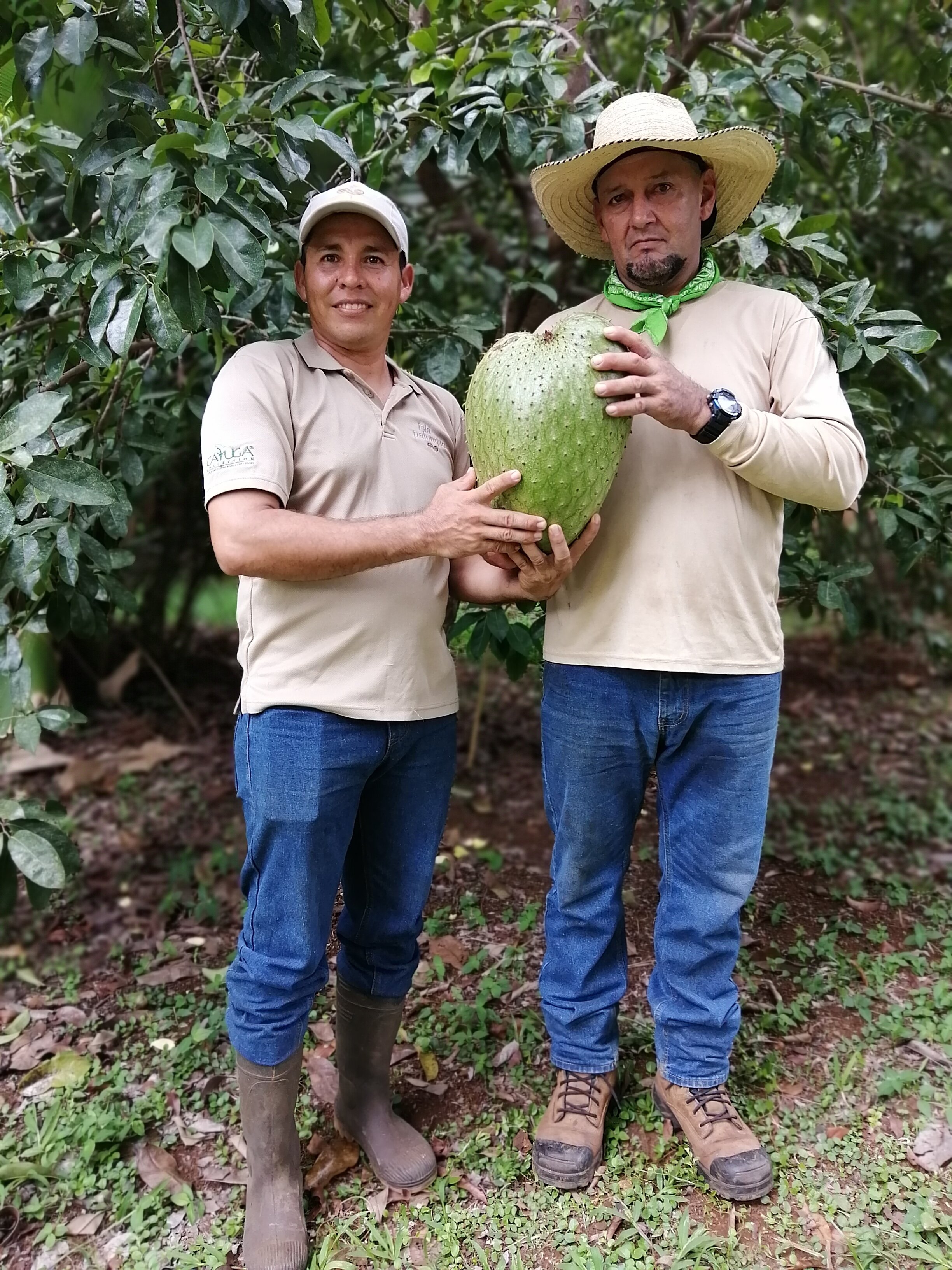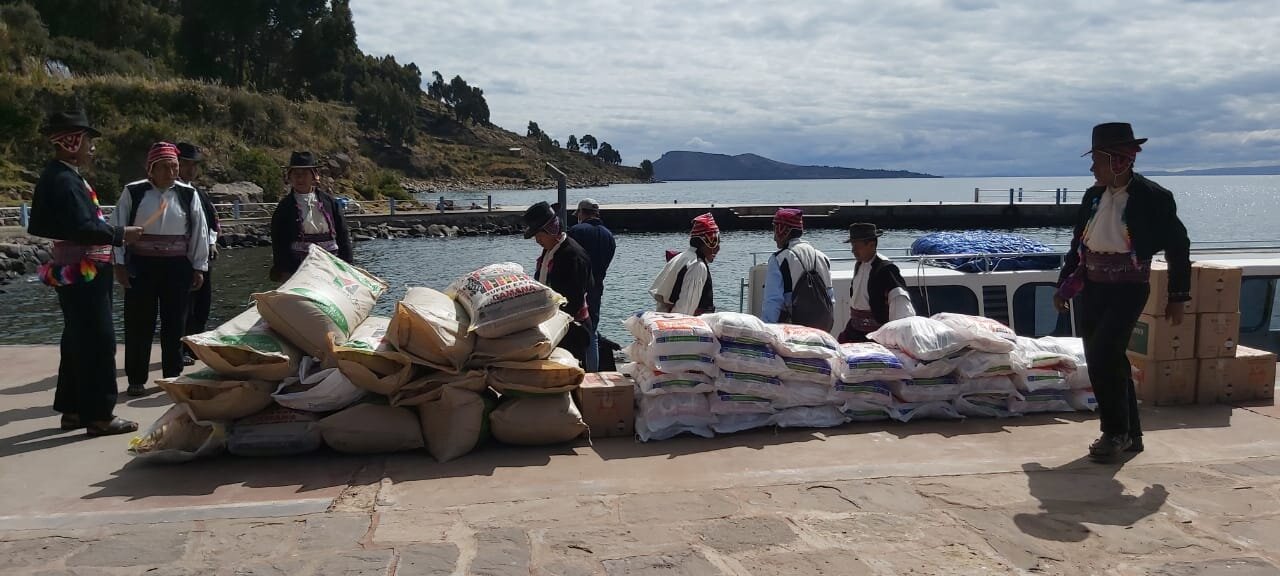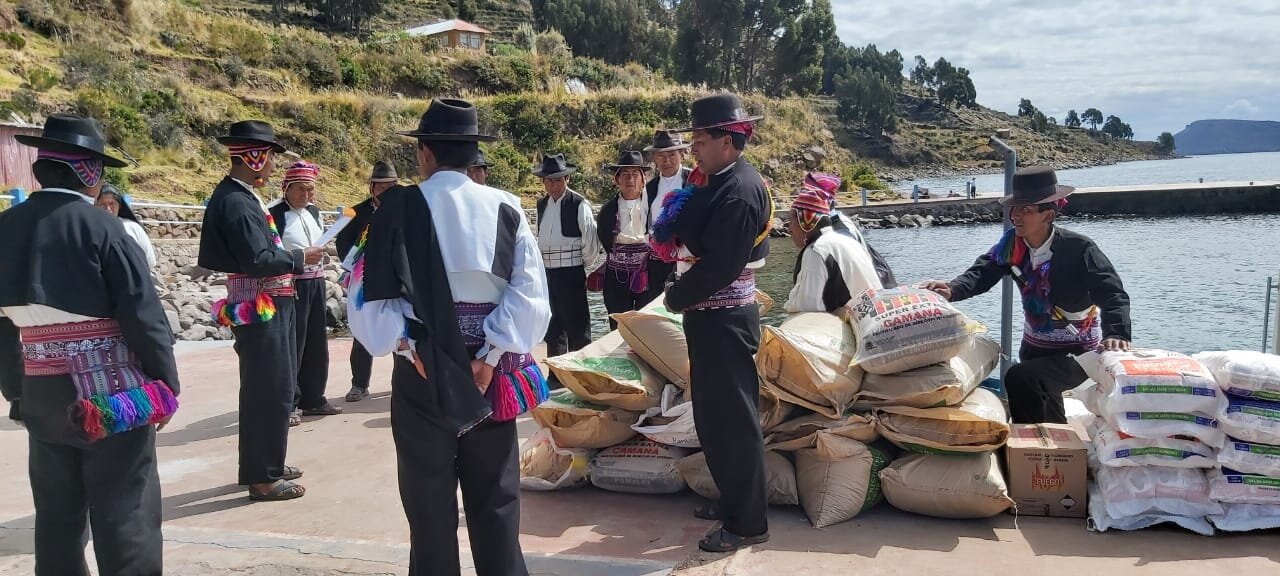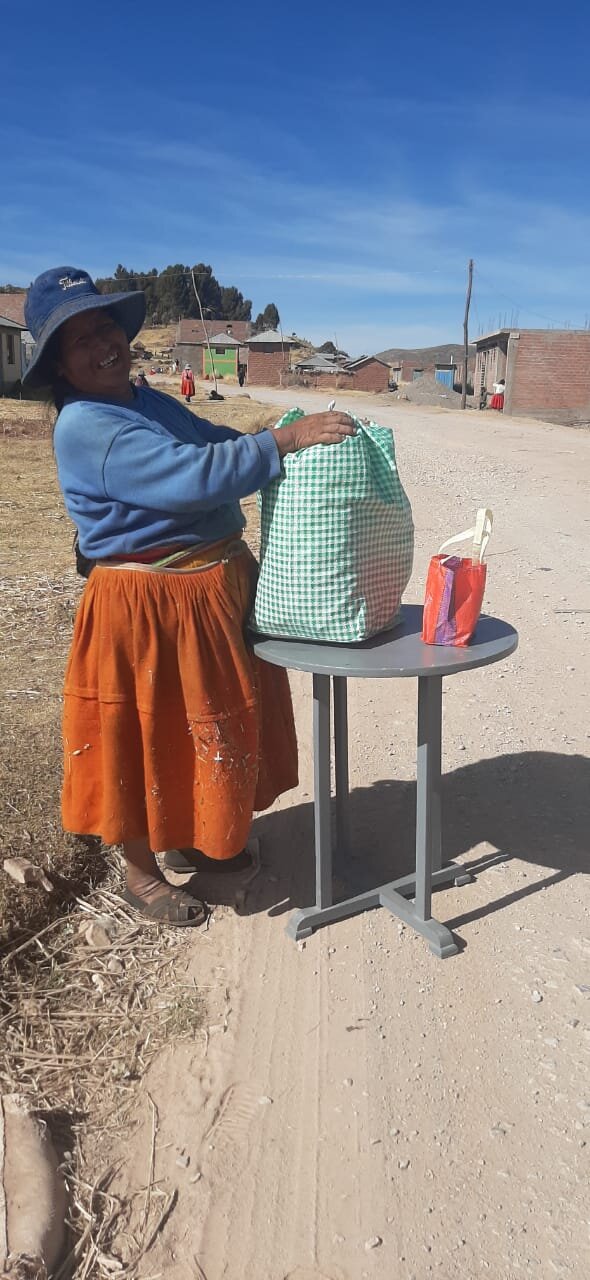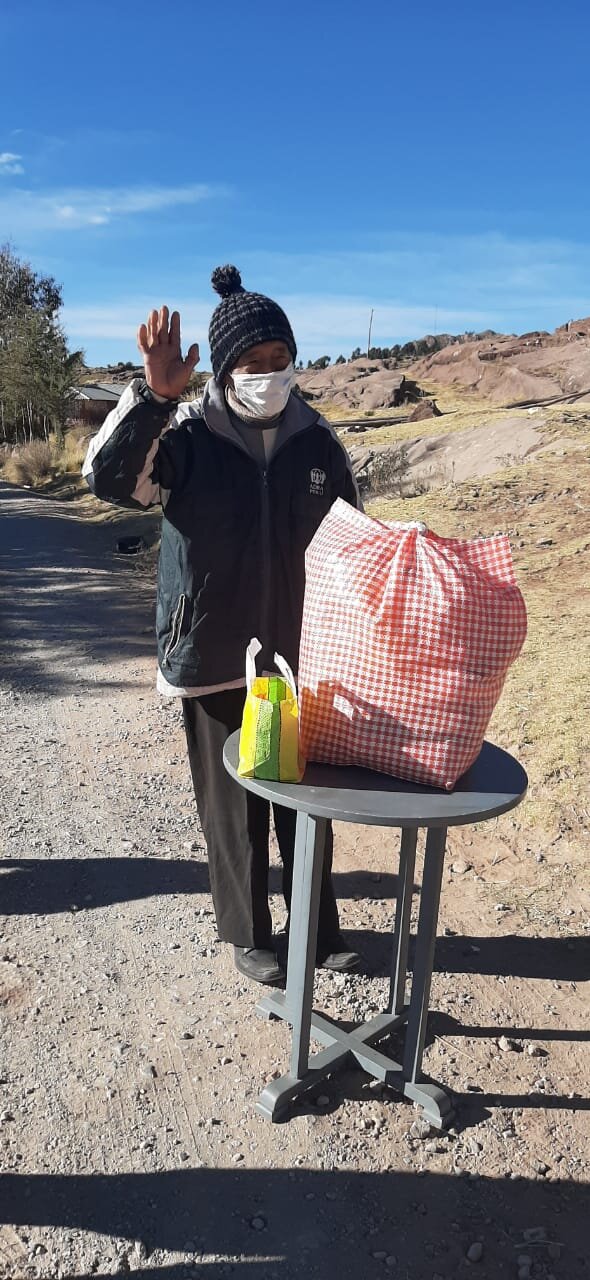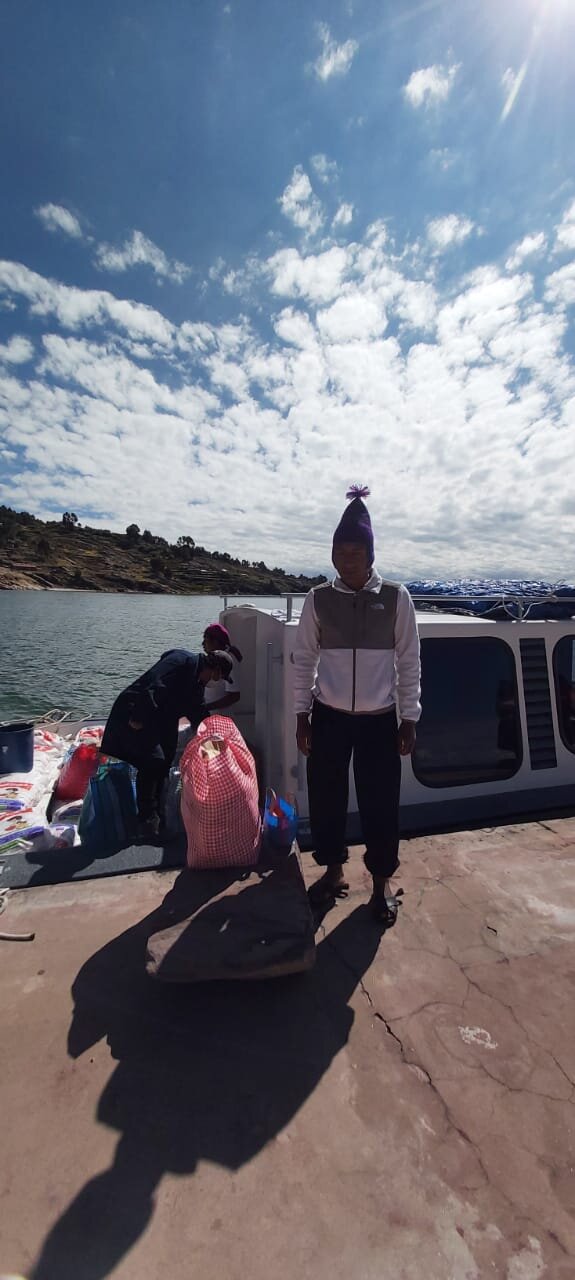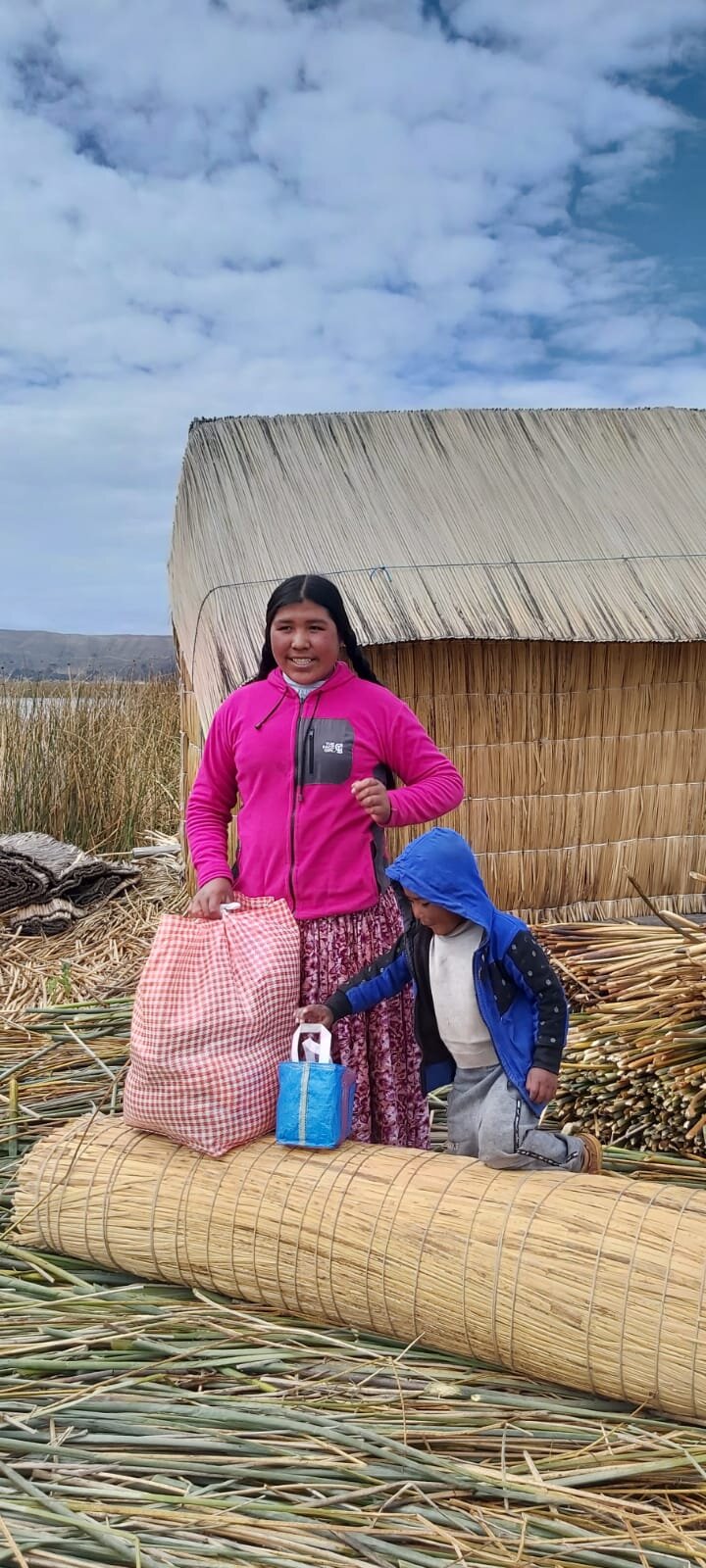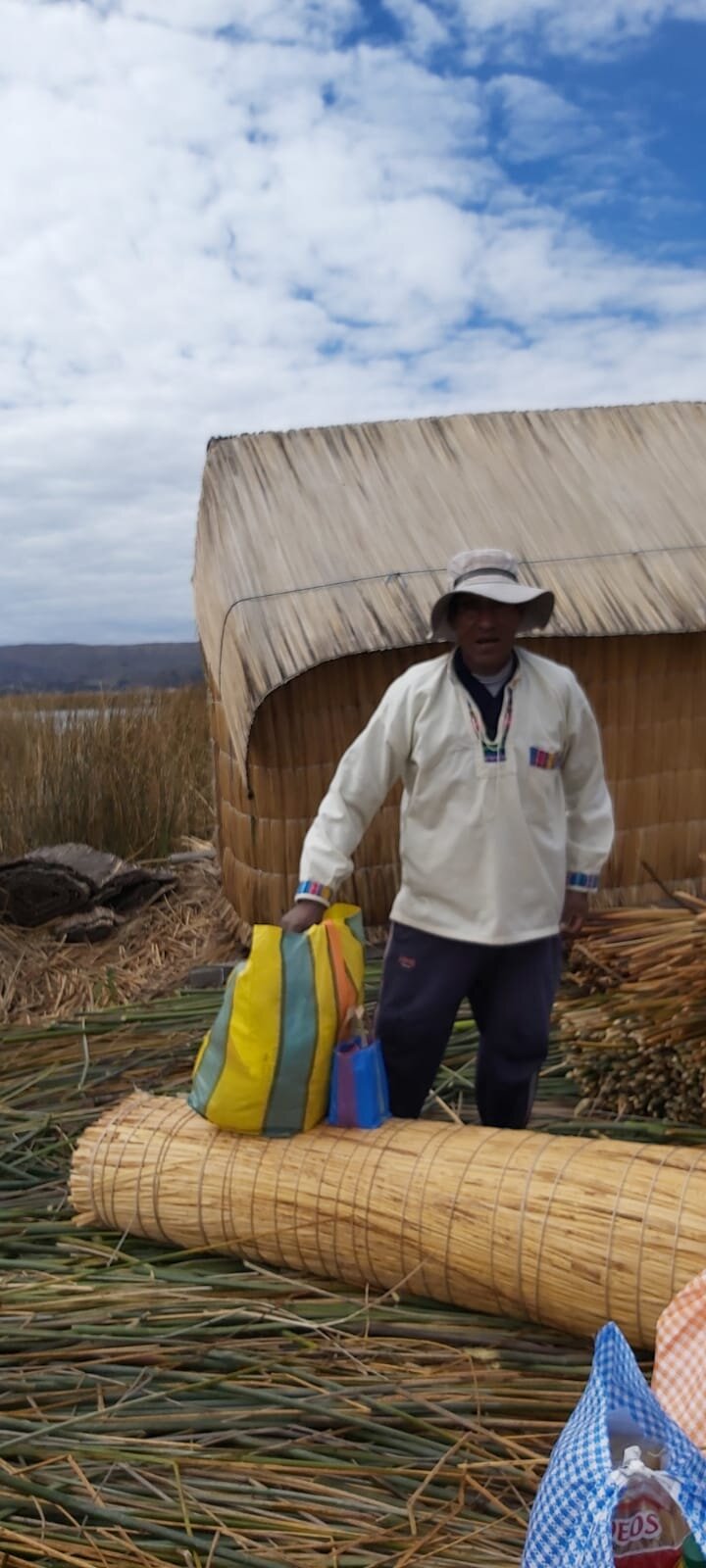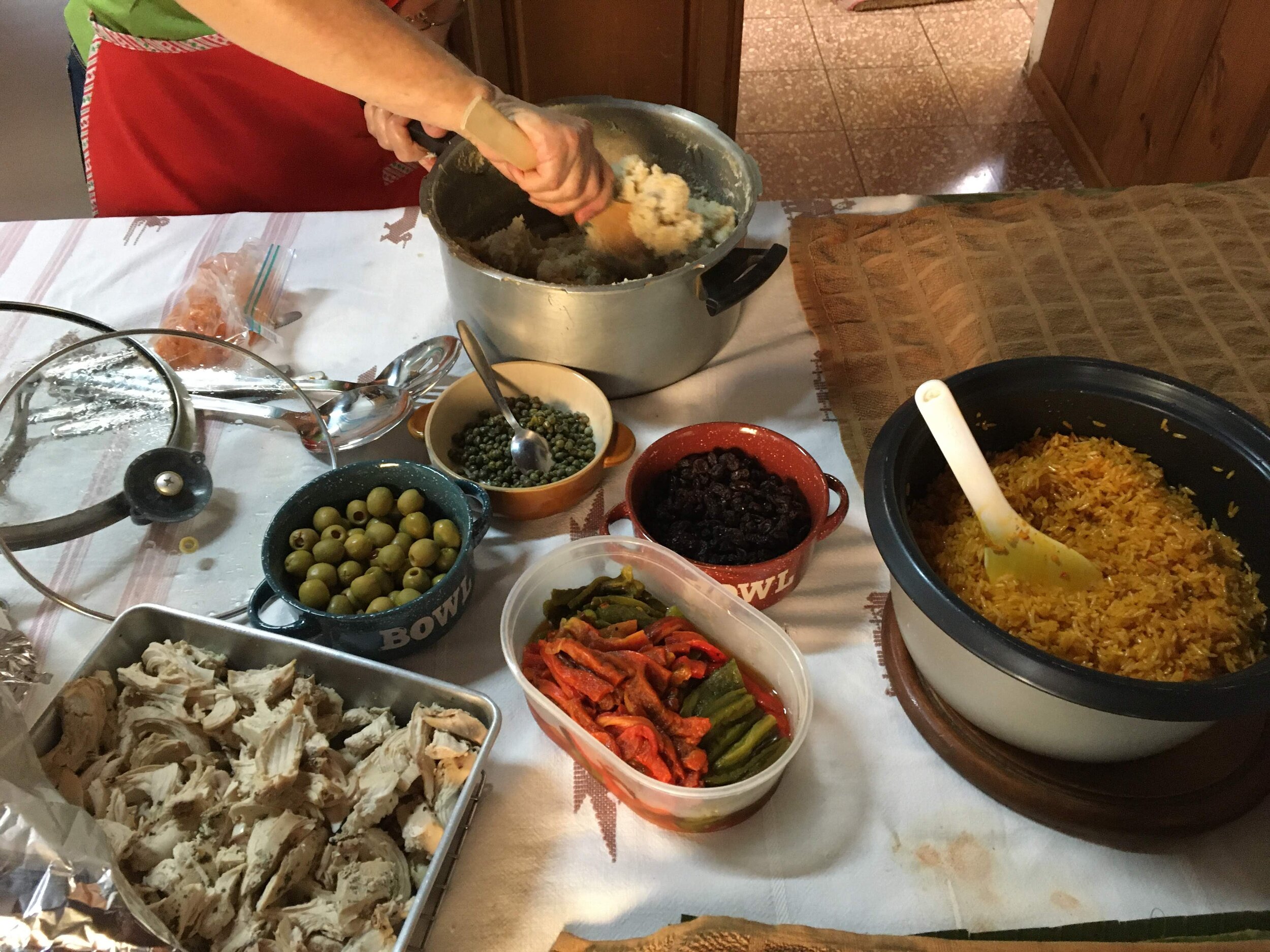An Identity Crisis at Isla Palenque
At Isla Palenque, staff have used the period of border closures to swap roles and develop new skills. And some have even discovered new passions for birding and farming!
An Identity Crisis at Isla Palenque
The absence of guests on Isla Palenque has caused an identity crisis among the team, leading to some career changes. Chefs have departed the kitchen to become birders, managers have moonlighted as English teachers, naturalist guides have developed an interest in farming & the head of HR has moonlighted as a photojournalist. Is this a case of island fever? Just what exactly is going on behind the scenes while Panama’s borders are closed?
Chef Jean Discovers a Love for Birding
Chef Jean (foreground) birding with Isla Palenque head naturalist guide, Chava.
You never know when a new passion might take hold of you. Jean is Isla Palenque’s talented chef who uses the plate as his artist’s canvas. He’s an early riser by nature, but without the need to be in the kitchen to oversee breakfast for Isla Palenque’s guests, Jean has used the morning hours to join the resort’s naturalist guides on their birding walks. His intuitive eye for detail has drawn him to the hobby, focusing on the variations in shapes, color, appearance and calls that distinguish the 55 (and counting) bird species that make their home on or near Isla Palenque. The change in seasons has also brought a number of migratory birds to the island - where they’ll pause for a few days before continuing their trip - adding another layer of intrigue to the identification process. Isla Palenque regularly offers daily birding tours at sunrise and sunset, at various points around the island to expose guests to the variety of birds that inhabit the various ecosystems, from dry tropical forests to wetlands to palm forests & coast. Perhaps one day the birding guide ensuring that you spot the Lineated Woodpecker will be the same individual serving you a perfect tropical curtido for lunch - Chef Jean!
English Lessons for Staff
While all front of the house staff at Isla Palenque are multilingual and fluent in English, many members of the grounds crew and maintenance team don’t feel comfortable or confident enough to interact with English-speaking guests. At the onset of the border closure, several team members approached management about using this time to improve their English communication skills. Isla Palenque’s GM, Patricia, and Chava, head naturalist guide have organized free & voluntary conversational English classes for all island staff, with the support of Cayuga’s Sustainability Program & Career Ladder. Classes are held twice a week on Tuesdays & Thursdays and response from attendees and teachers alike has been full of enthusiasm. To date, several students have maintained perfect attendance.
Peppers ready to be picked
Hyper Local Farm to Table
It’s been a goal since Isla Palenque’s inception to have a garden, small farm and greenhouse on the island capable of fulfilling the food needs for guests and staff alike. This is not only to reduce the number of weekly trips to markets in the Chiriqui Highlands but to offer guests more hands-on culinary experiences and ensure that our menu centers on food that has been organically & sustainably cultivated every step of the way.
Farmer Chava and his chickens
But like every gardener knows, it takes time and careful observation of the natural world to understand what coaxes the most abundance out of a particular patch of dirt. The team at Isla Palenque spent two years testing the soil with various organic additives and fertilizers & identifying the beneficial relationships of certain native tropical plants with domesticated fruits and vegetables. Today, the island’s garden is 100% organic and more fruitful than ever. The garden, greenhouse and flock of chickens (32 laying hens and 23 “Broilers”) are the pride and joy of the entire staff and two dedicated gardeners, Lolito and Eveilo. Chava, Isla Palenque’s lead naturalist guide, has also taken a keen interest in the garden and farm activities and always lends a hand with the daily chores. While most of what is cultivated will end up on the menu once guests return to the island, currently Isla Palenque is spreading the abundance around and ensuring that all staff and many local families in Boca Chica receive regular food deliveries of fruit, vegetables and eggs.
Lolito, Eveilo and a giant Guanàbana, which later became ice cream
Some of the fun culinary creations the staff have enjoyed and learned how to prepare recently include farm-to-table pizza and Guanàbana (Soursop) ice cream, which features a tropical fruit that grows wild on the island. When guests come back to Isla Palenque, they’ll be able to visit the “Granjita” on the Sustainability Tour and pick their own produce and eggs for culinary activities with the Chef.
Photojournalism 101
The photos featured here are all from Chava and Xavier (Isla Palenque HR Director), who participated in the Cuenta Cuentos Workshop arranged by The Cayuga Collection. Cuenta Cuentos means “story teller” in Spanish. All interested staff members from each Cayuga hotel were invited to attend a series of online workshops, hosted by Coffee Abroad, in which participants learned how to capture better photos with their cell phones and develop an eye for everyday scenes that tell an interesting story and convey the human aspect of hospitality that we’re all sorely missing right now. And while a screen won’t ever replace the warmth of a genuine smile or a personal conversation on the beach while sun sets (interactions that come naturally to these hospitality professionals), the social media & marketing skills introduced in these workshops may eventually lead someone to a different career! It’s all about planting that first seed of possibility, introducing new ideas and experiences and encouraging individuals to explore their potential.
Some of Isla Palenque’s core team. From L to R, Xavier (HR), Patricia (GM), Jean (Executive Chef) and Chava (Lead Naturalist Guide).
A National Geographic Unique Lodge of the World, Isla Palenque is part of the Cayuga Collection’s larger family of sustainable luxury hotels and lodges in Costa Rica, Panama and Nicaragua. At Cayuga the opportunity for local staff to grow in their careers and develop both professionally and personally is part of the company’s DNA. Cayuga’s commitment to their people - and steadfast belief that all team members with great attitudes and enthusiasm can be taught the skills to aspire to the highest levels of hospitality and beyond - isn’t just a marketing slogan. They live this mission every day through programs both large and small that enrich the lives of their staff and the communities surrounding their hotels and lodges. In 2018 the World Travel & Tourism Council recognized their efforts with the prestigious Tourism for Tomorrow Award in the People Category.
Please visit our travel industry page, Isla Palenque, for more information on this 400 acre tropical island escape in Panama.
Awasi: Setting the Table for Reopening
What have the staff at Awasi been up to during the pandemic? Setting the table for a spectacular reopening.
Awasi: Setting the Table for Reopening
Everyone who works in the travel and hospitality industry has been in a constant state of flux since March 2020. We find ourselves faced with a situation we don’t have immediate control over, the desire to get back to work in delivering outstanding experiences to international travelers. Until the borders are open and flights resume again, all we have is time on our hands. How have the top properties in Latin America been using this time besides fine tuning “health and safety protocols” which is just a given at this point, for every player in worldwide tourism and hospitality, and frankly should have been a matter of major importance even before this global pandemic.
Tomas and Chris - Guides at Awasi Patagonia
I wanted to share an inspiring story about some things that Awasi has been doing.
Awasi has made it a priority to retain all of their staff for as long as financially possible. No amount of beautiful hotel infrastructure is ever going to replace the talent and special energy brought by the hard working people behind the experience. You take away the people, you take away the soul of a property. So what do you do with such a large staff during such slow times? You take the opportunity to make them even better.
There is nothing more motivating than seeing and hearing an individual talking passionately about what they love to do. We seldom get a chance to really take a peek behind the scenes into professions that differ from our own. But running a top tier luxury hotel draws on so many diverse talents, and they all must come together perfectly, in order to deliver a seamless guest experience.
In that spirit, “Awasi Talks - For and By Us”, was created as an internal exercise to share knowledge between different sectors of staff and build company cohesion. The idea was simple enough, allow staff members from the three different geographic properties in the Atacama, Patagonia and Iguazu Falls - working in different sections of the hotel operation, to create and carry out a presentation for the whole company, via zoom. This was not mandatory, but put out there to staff if they wanted to share. The topics turned out to be fascinating, here are just a few of them that have already been completed:
“History of the Jesuit Missions” - by guide, Jimmy McCormick
“A Cup, A Story” - by sommelier, Dana Cordoba
“How to Make Churros” - by pastry chef, Valentina Marambio
“Electrical Installation” - by maintenance staff, Nicolas Arman
“How to Speak in Public” - by excursion manager, Paula Bertotto
“Excursions We Offer” - by excursion manager, Tomas Navarette
Nicolas Arman, maintenance at Awasi Iguazu, presenting on electrical installation.
The Awasi Talks have been a fantastic way for employees of Awasi to get to know one another on a personal level, and for each to deeply understand the small part they play in the big picture. The Chef and Sommelier probably don’t think much about what the guests and the guides are doing out on excursions every day, but after learning how strenuous certain excursions may be, it could just make them think about throwing in a few extra energy bars or picking a wine warmer on the palate for the picnic supplies when they know Tomas is hiking to the Base of the Towers with his guests today - and likewise, Diego might be more on top of his time management when he knows that the Chef has prepared a special asado for the guests that will begin promptly at 7pm. This creates a cross pollination of awareness and appreciation for the team and the role everyone plays in it. How great is it that the head of maintenance offered to do a presentation on electrical installations?! Again, every single part of the hotel operation has to be seamless, and these Awasi talks have allowed for the staff to deeply understand and appreciate this fact.
Matias de Cristobal, Managing Director
These talks have been capped by leadership webinars for all staff by Matias de Cristobal, Managing Director of Awasi on “The Awasi Concept” - exposing all staff to the concept and methodology behind what Awasi does and how Awasi does hospitality and tourism differently. My favorite analogy that Matias uses to describe the Awasi Concept is a round table, sitting outside in a natural setting - on which the guest experience sits. The natural setting, i.e The Atacama, Patagonia and Iguazu Falls cannot be improved upon and were carefully selected as a place to set down that table. However, that table, which holds up the guest experience, is only supported by three legs. Those three legs are; 1) The Physical Hotel 2) The Excursions 3) The Gastronomy. If any one of those three legs is shorter or not as strong as the other ones, the table will wobble and not be solid. The Awasi Talks play right into this analogy, the role of every employee at Awasi is vital in keeping their leg of the table strong, so the guest experience is phenomenal.
The Awasi table is set, the legs are stronger than ever, and we look forward to inviting you to pull up a chair to it very soon.
Explore the Awasi Properties:
Awasi Atacama Travel Trade Page
Senda Monteverde Reopens For Local Travelers
What will the future of travel look like? Senda Monteverde in Costa Rica offers a glimpse, with sold-out weekends (at mandatory 50% occupancy), updated health & safety measures and the warmth, personalization and care that travelers and hospitality fans have been sorely missing!
Senda Monteverde Reopens For Local Travelers
Over the past few months, you’ve probably attended more zoom meetings than you can count where the topics “What will the future of travel look like?” and “Will people want to travel?” have been discussed and debated ad nauseam. We’re happy to share that the time for crystal-ball gazing is over, at least for Costa Rica. Always a leader in the region, Costa Rica became one of the first countries in Latin America to successfully reopen to domestic tourism and is poised to begin welcoming international visitors on July 1.
Plastic visors, social distancing, QR codes for menus but the same friendly service + healthy, organic & delicious choices. Welcome to the future of dining at El Sapo, Senda Monteverde’s Restaurant.
Senda Monteverde, the Cayuga Collection’s cozy mountain lodge tucked up in the Cloud Forest, opened on June 5th to welcome local travelers for much-needed weekend getaways. While certain restrictions remain (hotels & restaurants may only operate at 50% only parks & reserves require advanced reservations due to limited capacity), Senda Monteverde has sold-out every weekend since opening and guests have been raving, both about the changes but also about the refreshing & prevailing sense of normalcy. Check out The Cayuga Way Blog for a recent guest review from the Hammond Family, architects & Costa Rican residents who stayed at Senda Monteverde over opening weekend. After three months of home schooling and WFH, a weekend walk in the Cloud Forest was just what everyone needed.
Lake Titicaca Communities Support Fund
Lake Titicaca Communities Support Fund
When things are difficult for you, it often opens doors in which to reflect on your situation, and realize that others may be in a more difficult situation than you.
The Coronavirus pandemic has caused the global tourism and hospitality industry to grind to a halt. Those that work in the industry have seen their business go from 100 to Zero in the span of a few weeks, no new bookings are coming in, only cancellations and postponements. From hotel owner to tour operator to guide to airline steward to travel agent, we are facing challenging times with no clear end in sight. But we are directly involved in the industry. What about those that are indirectly involved in the industry?
What lures people to travel to far off lands is not just fancy hotels and exotic landscapes, it is the people they meet along the way that don’t directly work in tourism, but make the tourism experience so magical. We are all human after all and share in that primordial connection, that as different as we may appear on the outside, inside we are all the same.
It was in that spirit that Titilaka Lodge on Lake Titicaca decided to launch the Lake Titicaca Communities Support Fund. The indigenous communities that surround Titilaka are an essential part of what makes the guest experience so special and unique in the world. These communities have been part of the hotel’s extended family for many years and they have touched the lives of visitors from all corners of the globe. Although not directly involved in tourism, a large part of their local economy is driven by tourism money coming in. No tourism has meant a drastic decline in their local economy.
The Lake Titicaca Communities Support Fund is a fundraiser to supply basic food items and virus-protective supplies to 150 families in the four communities surrounding Titilaka Lodge. The goal is to collect 31,500 USD. This amount will provide a basic food basket for one month and a virus-protective supply kit per family.
Since launching one month ago, we have received 60 donations, from as small as $5 to as large as $2000, from people all over the world who have been touched by the communities of Lake Titicaca before and want to share some love. We have only reached 1/3 of our goal but are already making good on the promise to deliver these baskets to as many families as we can. I wanted to share some images of the first round of donations being delivered.
We still have more families to reach, so if you feel like you can spare $5 or more, we appreciate your support and you can donate and leave a message on our GoFundMe page.
A Message From Clark Kotula and Webinar Schedule
A message about COVID-19 from Clark Kotula and our webinar series invitation.
A Message from Clark Kotula and
May Webinar Schedule
I remember the last real hug I received from a stranger, it was March 12th around 8:30pm while at a travel industry event in Montreal. She was a Moroccan living in Canada and we shared stories about Morocco, me telling of my fond memories and appreciation of her beautiful homeland and culture - which brought out in her an overwhelming mixture of pride and homesickness - the moment culminated in a natural deep hug between us. Two strangers prior to that day were brought together through a love of travel and the human connection it fosters. The next morning I jumped on my last flight home to San Francisco with no idea that I’d be thinking of that innocent hug, and all it represented, almost 50 days later.
So much is out of our control right now: when will borders open, when will flights resume, when will kids go back to school, how long will the money last, are people even going to travel when it is possible, what will that look like? I’ve found great comfort in focusing just on the things that I have immediate control over and narrowing my focus to things that really MATTER: spending time with my family, looking after my children’s education and using the time to learn things I never had time for previously, caring for my local community and showing kindness, being thrifty with finances and spending money outside of the necessities only on things that bring real happiness and value to myself and those around me.
And I’ve seen that the carefully selected portfolio of properties we represent throughout Central and South America are thinking and acting the same. They are focusing on caring for the communities and environments that they directly support through tourism. None of them were created in the first place with the end goal of being a cash cow - they are small independently run properties that are rooted in welcoming visitors to their unique corners of the world to show them the wonderful people and landscapes they offer, and tourism allows them the financial means to care for their local communities and environments in return. The owners have always been on the path to figure out how to build a more sustainable, compassionate and purposeful travel experience - not on reporting profits to shareholders. Travelers who go to these properties leave feeling a deeper connection with their fellow humans and the destinations they came to experience, period. And these sort of attributes in travel experiences are going to be as important as ever now, as the world has been forced to slow down and take stock of what really matters in the long run, and separate it from the fluff of excess.
So when I think of that last hug in Montreal, and all it represents, it melts away the worries I have over things that are not directly under my control right now. Borders will open up, flights will resume, kids will go back to school, money will start flowing again and people will travel, no doubt. We are a species that is naturally curious, prefer to chase emotions over material things and crave human connection. We will hug again soon.
If this message resonates with you, then you might be interested in joining Kirsten and I on this series of webinars about the portfolio of properties we represent across Central & South America. We are going to focus on not just how to sell them, but why to sell them, and why now more than ever. They are all, by and large, in remote settings, extremely small, run by local communities, offer private services, are in bucket list destinations and dedicated to transformational travel practices that we believe will resonate even more with the post COVID-19 world traveler.
We welcome you to sign up for as many as you wish, even if you can’t make it on the time and date, we will send you the recording afterwards with “cliff notes” on what you missed. And we also welcome those that already know, sell and love these properties to join us too. Rather than ending with a Q&A session, we want to end with allowing those with experience of the properties and sending their guests there to share their connection with them and answer questions by their fellow travel peers.
For companies with 5 or more sellers of travel who would like to arrange a private, more interactive, brainstorming webinar on a certain destination or property, select the Private Webinar below which leads to a form where you can request that.
Our Recommended Reading List for Latin America
Want to dive into a country beyond a guidebook? Pick up one of our favorite books and it will have you planning your next trip to Latin America. We have recommendations for Chile, Colombia, Panama, and beyond.
Our Recommended Reading List for Latin America
Want to dive into a country beyond a guidebook? Pick up one of these and it will have you planning your next trip to Latin America.
Chile:
Life and Death in the Andes: On the Trail of Bandits, Heroes and Revolutionaries by Kim Macquarrie consists of short stories along the spine of the Andes from Tierra del Fuego to Colombia. The author’s ability to share so much knowledge and detail on cultural, historical, anthropological, geographical, environmental, aspects but in a way that leaves you not wanting to put the book down and as if you are along on a great adventure story.
The House of the Spirits by Isabel Allende – The saga of a family across four generations that also traces the turbulent history of an unnamed Latin American country (which pointed similarity to Chile.)
Poetry of Pablo Neruda – Chile’s Noble prize winning poet and later politician. Favorites include Twenty Love Poems and a Song of Despair, The Captain’s Verses , Odes to Common Things and The Book of Questions
Colombia:
One River by Wade Davis is a rollicking adventure story that crisscrosses the Andes from Colombia down to Peru, that touches on so many topics it’s hard to summarize in a paragraph. Tie together botany, ethnobotany, natural history, indigenous tribes, world history, culture and conquest and you have a book that will leave your head spinning and ready to jump on your next flight to the Andes.
Love in the Time of Cholera by Gabriel Garcia Marquez – Young and passionate lovers, Fermina and Florentino are separated by social class and grow apart to live separate lives throughout decades. After 50 years of marriage Fermina’s husband finally dies falling out of a mango tree (trying to retrieve his pet parrot) and Florentino confesses his undying love to her once again at the funeral, claiming to maintain a pure heart over the years despite hundreds of affairs and trysts with other women. (also a film)
The General In His Labyrinth by Gabriel Garcia Marquez – Fictional recollection of the last days of Simon Bolivar as he faces death and cynically reflects on his life. Darker than his other books.
Ecuador:
Huaoroni woman of Ecuador.
Savages by Joe Kane takes readers deep and intimately into the Ecuadorian Amazon to tell the tale of the Huaorani Tribe and their fragile tightrope walk between defending their ancestral traditions and history against the onslaught of missionaries, oil companies and the government. A fantastic book about Ecuador.
The Panama Hat Trail by Tom Miller. Most people don’t realize that “Panama” Hats are actually made in Ecuador. This book not only tells you this but uses the Panama Hat as a literary focus to tell the tale of Ecuador from a unique angle.
Nicaragua:
The Jaguar Smile: Salman Rushdie’s first nonfiction book about his travels in Nicaragua in 1986, in the midst of America’s behind-the-scenes war against the Sandinistas. Great story telling about the people, politics, land and poetry of Nicaragua from a perspective that isn’t told in the United States.
Panama:
The Path Between the Seas by David McCullough. Thorough by engrossing epic that traces the creation of the Panama Canal and packs a ton of historical detail that provides the traveler with context for understanding Panama today.
Folks from the Pacific Northwest probably know Stevens Pass, named for railroad engineer John Stevens. But did you know that he was also Chief Engineer on the Panama Canal project from 1905-1907? His experience was instrumental in rebuilding the Panama Railway to serve as a tool to aid the Canal construction and he also convinced Theodore Roosevelt to pursue a plan of locks & dams rather than a sea-level Canal like the French had proposed.
Peru:
Last Days of the Incas by Kim Macquarrie is the definitive historical narrative of the discovery and conquest of the Incan Empire by the Spanish. This is the one book to read if you are going to Peru.
Turn Right at Machu Picchu by Mark Adams is a great adventure book about exploring the true “lost cities of the Incas” in modern times. Part travelogue and part historical narrative, this book will get you excited about adventuring in the Incan heartland and introduce many characters still involved in the tourism landscape of Peru today.
Death in the Andes by Mario Vargas Llosa. Thriller, mystery & political allegory. Three male laborers go missing in the Andes and two Peruvian Army officers are sent to live among a remote village while they search for them. Weaves the modern terror of the Shining Path with ancient about monsters (pishtacos – a pale vampire) and black magic in the high Andes and the mistrust of people from different worlds.
Miscellaneous:
A Neotropical Companion by John Kricher is the definitive handbook for anyone traveling to the tropical rainforests of Central or South America. Any biologist or naturalist has this in their travel library and uses it until it falls apart apart and they are sent looking for a new one.
The Motorcycle Diaries – Ernesto Guevara’s Memoirs of nine months on the road in Latin America that shaped the future revolutionaries’ beliefs that the only way to correct institutionalized inequalities was to enable the poor to rise up in armed revolution.
The War for Don Emmanuel’s Nether Parts by Louis De Berniers – Hilarious parody on magical realism and many of the themes common to Latin American literature. The first of a trilogy. Highly recommend all three if you enjoy the first one.
The Book of Embraces by Eduardo Galeano – Poems, short stories, illustrations and prose by the Uruguayan author – a mix of autobiography, political commentary and magical realism.
Did we omit a book that should be on this list? Leave a comment and let us know!
Postcards from Latin America: Hacienda Bambusa by Julie Law of TWIL Travel
Postcards from Latin America: Advisor Julie Law shares a snapshot of her family’s recent trip to Colombia and experience at Hacienda Bambusa!
Postcards from Latin America:
Hacienda Bambusa by Julie Law of TWIL Travel
Advisor Julie Law of TWIL Travel recently explored Colombia with her family on an itinerary that included Cartagena, Bogota and the country’s famed “Coffee Triangle” where they fell in love with the rustic, rural charms of Hacienda Bambusa. Thank you to Julie for kindly sharing this “virtual postcard” from your time at Hacienda Bambusa, one of the happiest places in Latin America! We hope this inspires everyone reading to keep dreaming and looking ahead.








“Set in the middle of Colombia’s coffee region, surrounded by spectacular lush green mountains, sits the simple and elegant Hacienda Bambusa. With just eight suites and the friendliest, most attentive staff, Hacienda Bambusa offers a lovely home away from home experience in the highlands.
I knew this place was special the moment we arrived and were greeted by a chorus of cicadas and the chaotic flurry of different bird activity.
You might think that Hacienda Bambusa’s remote location would limit your options of activities but that’s not the case at all. Choosing between horseback riding, hiking, biking, coffee tasting, cacao tasting, bird watching or just to stay put to enjoy the pool were the biggest most stressful decisions I had to make during my family’s 3-night stay.
And my 15-year-old daughter (who I admittedly was worried would be bored) was just as enchanted with Hacienda Bambusa as the older couple we met! Having just returned from an incredible trip to Bogota, Armenia and Cartagena, I can say with confidence that staying at Hacienda Bambusa is a must on any trip to Colombia. You have to experience it to understand!”
Costa Rica Property Webinars: January 2020
Register for our webinars on Hotel Aguas Claras + Kurà and Senda Monteverde + Arenas Del Mar.
Costa Rica Property Webinars: January 2020
Kirsten is hosting webinars this week, covering news & updates from our partners in Costa Rica. Register directly via the links below. Even if you can’t attend during the live session, register regardless to receive a recorded copy and all associated sales & marketing materials. Each webinar will last approximately 30 minutes.
Hotel Aguas Claras & Kurà:
Inspired Design in Southern Costa Rica
When: Thursday, January 23rd @ 10:00 am Pacific Time
What: Discover the new Hotel Aguas Claras, the first luxury property on Costa Rica’s Caribbean Coast. Catering to adults, this hotel pairs well with Kurà for honeymooners and adventurous travelers seeking stylish, boutique properties that are off the beaten path.
Costa Rica 101: Senda Monteverde + Arenas Del Mar in Manuel Antonio
When: Friday, January 24th @ 10:00 am Pacific Time
What: The cloud forests of Monteverde combined with the rainforest & beaches of Manuel Antonio is a perfect & easy first trip to Costa Rica for families & travelers of all ages. Senda Monteverde & Arenas Del Mar are the top choices in either area, with ideal locations, exceptional staff & a variety of recent upgrades and on-property experiences that add considerable value when compared to other lodge options.
The Perfect Panama Itinerary for Families
The perfect 7-Night Panama Family Itinerary combining culture, nature, both coasts and two unique experiences at El Otro Lado & Isla Palenque.
The Perfect Panama Itinerary for Families
Your clients have already ”done” Costa Rica. Or maybe they are on the hunt for a destination that offers indigenous cultures, a cool city vibe, wildlife, adventure AND beautiful beaches. And is accessible via a relatively short nonstop flight from North America. And is warm, doesn’t come with altitude concerns, can be experienced within a week and is safe.
Panama checks all of these boxes and more and has been perhaps our most-requested destination so far in 2020. Travelers are often surprised at how modern and well-developed Panama is. Great infrastructure, paved highways and the USD as currency stand in contrast to 16th century fortifications, dense, impenetrable rainforest and indigenous groups such as the Embera and Guna Yala who maintain traditional lifestyles in the rainforest and on islands. The cultural diversity of the country is often unexpected as well, though the whole world has been transiting Panama for centuries and the influence of African, Chinese, Indian and European cultures can be observed especially well in the country’s culinary scene, a standout in Central America.
With our partners at El Otro Lado Private Retreat in Portobelo and Isla Palenque in the Gulf of Chiriquí, we’ve put together an ideal 8-Day/7-NightPanama Family Itinerary featuring the two best properties in Panama catering to the high-end traveler market while still being accessible, authentic and without pretense. For outstanding service, unique experiences and a selection of room options that work for families of different sizes (plus pools & water toys at both properties to occupy the kids while parents can sip a cocktail), this trip is hard to beat and has been thoroughly vetted and approved by Clark’s two sons, ages 7 and 10. (And they are tough to impress - having been every where!)
Highlights include:
Watching huge cargo ships traverse Gatun Lake from the Panama Canal Railway
Getting a lesson in percussion and rhythm from students at La Escuelita Del Ritmo in Portobelo (a free music school supported by El Otro Lado)
Learning about Congo cultural traditions and then painting in the Congo style
Wake boarding in front of a 16th century fort
Searching for Howler monkeys and sloths
Boogie boarding the waves at Isla Palenque
Discovering the remains of ancient, vanished cultures on the Secrets of the Island Walk
Snorkeling among coral reefs and visiting uninhabited islands in the Gulf of Chiriqui
Watching humpback whales breach and play with their babies in the waters around Isla Palenque (late July - early November)















The itinerary has been written with the travel professional in mind and is full of our notes on timing, flight options and recommended experiences in Panama City. We invite you to download this trip as a Word Document to send to prospective travelers, customizing as you see fit. You can also send it directly to your preferred Panama DMC or Tour Operator partner for a quote & their input or contact Kirsten at kirsten@clarkkotula.com for suggestions on how to put it all together.
La Tamaleada! A Christmas Tradition from Central America
In Central America tamales are an iconic part of the Christmas season, a delicious way to bring family members together to feast and celebrate their heritage. Silvia Solis, General Manager of Kurà, shares more about her family’s tamale tradition in Costa Rica.
La Tamaleada! Exploring a Central American
Christmas Tradition
Silvia, on the job at Kurà. Not making tamales.
Preparing, sharing and eating tamales is a beloved Christmas tradition throughout Mesoamerica - the cultural region spanning from Mexico to Costa Rica in which people share certain traditions, language and histories that date back to pre-Colombian times. Every year in early December, families and friends in Costa Rica gather for Tamaleadas, or tamale making parties, to divide and conquer the many labor-intensive and time consuming steps required to produce the delicious, leaf wrapped packages. Recipes and key ingredients will vary from family to family, but the significance of the tamale remains the same; a beloved ritual that brings family together to honor their heritage & celebrate the season.
I recently caught up with Silvia Solis, General Manager of Kurà, at an early December gathering in San Jose. From the city she was heading to her mother’s home for her family’s annual Tamaleada, which she kindly agreed to share with us below. Prior to joining Cayuga and working in hospitality, Silvia studied biology, conservation and ecology, attending graduate school and conducting field research in both Costa Rica and Mexico. She has sampled tamales near and far, but her mother’s remain her favorite.
Silvia’s signature tamale ingredients spread
“The "tamal" is a preparation that is purely Mesoamerican, there is no translation into English or any other modern language. It's a pre-Hispanic or pre-Colombian tradition, which means it was here way before the Spanish invaded Mesoamerica.
Tamales are basically a dough made from corn, masa - the same you use for tortillas. You can buy masa pre-made but my mother makes it herself. The corn must be white and has to be "cascado", which is the process to get rid of the peel or skin (this is the thing you get between your teeth from the popcorn!). To make our tamale masa, my mom cooks the corn with potatoes and also bacon fat which gives it a fantastic taste! In some recipes you’ll see that the fat or lard is added later in the process, but we add ours while the corn is still cooking. Once the corn is cooked we take it to the grinder, "molino de maiz, " and grind those three ingredients together into a dough. Then comes the good part, we mix the formed dough with a special blend of pork and chicken broth which has already been prepared previously, until the mixture has a texture like pudding. (Some people use just pork broth or just chicken, or a vegetarian broth if preferred.) Finally, the dough is then cooked down again, this time with the addition of lots of salt and pepper to enhance all of these delicious flavors.
Wrapped tamales ready for the final round of cooking.
The dough is prepared the same day you make tamales, but preparation for the other ingredients starts a couple of days prior. You have to prepare the broth, both chicken and pork meat, sauces (in my house we use a tomato sauce), rice with "achiote" (a natural condiment that gives a nice orange color to the food), carrots cut in small pieces, and then other various condiments. and fixings. In my house we create a "fusion" tamale blending ingredients from mediterranean cuisine, so we like to add capers, raisins, chickpeas and olives.
The other main task to accomplish before the main tamaleada is preparing the plantain leaves that are used for wrapping the packages. (Plantain or banana leaves are typical in Costa Rica. In Mexico and the American Southwest you are more likely to find tamales wrapped in corn husks.) The leaves must be trimmed to the right size and length, cleaned and then prepared "soasadas", not fully cooked but grilled just a little bit so they are flexible enough to wrap the tamales without breaking. To tie the tamales we use a cotton thread called "manila" or natural fiber from the plantain plants.
The day of the tamaleada starts early for the main chefs as we must prepare the masa dough and this step alone takes several hours. Once the dough is finished cooking and while it is still warm, we pour a scoop of it on to the plantain leaf and spread it a bit. On top of the dough we arrange the rice, meat on the side, peppers, other veggies and sauce on top. Of course the ingredients must have specific array and that's a "family signature"; my mom believes that how you arrange the ingredients is very important. When you open the tamal to eat it, it must look as good as it smells and invite you to devour it!
Silvia’s mother assembles the perfect tamale.
Once all the ingredients are in place and portioned correctly, we close the leaves with specific folds to seal out the water and pack the tamales in pairs to tie them up. The tie is very important, as the tamales must stay together through one more round of cooking! After all the tamales are ready, pair and tied, you must cook them one more time in a big pot with boiling water for about 45min. Traditionally the tamale pot is gigantic and we use a "fogón" or a fire on the ground so is easy to drop and pick up the tamales. If the folds and ties are good, then the tamales can boil for as long as necessary without any accidents like allowing water to seep through the leaves!
After the last cooking process you have to let them rest for another hour or until the cool down so that they hold their shape when you open them to eat. My mom was telling me the story of her first time making tamales by herself; she was so anxious to see the final product that she opened the tamal while still hot. Instead of retaining its shape the tamal “melted” and just spread all over the dish! You can imagine how upset she was after days of prepping and cooking - she started crying thinking that she had messed up the processed and ruined all of her hard work. But luckily my grandmother was around and explained that she just needed to be patient! “
Do you celebrate the holidays with a Tamaleada? Leave us a comment if you’d like to share your key ingredients or family recipe! And if you’d like to try making tamales at home, check out this version of a recipe from the Smithsonian: “La Tamalada: A Christmas Tamale Tradition”





